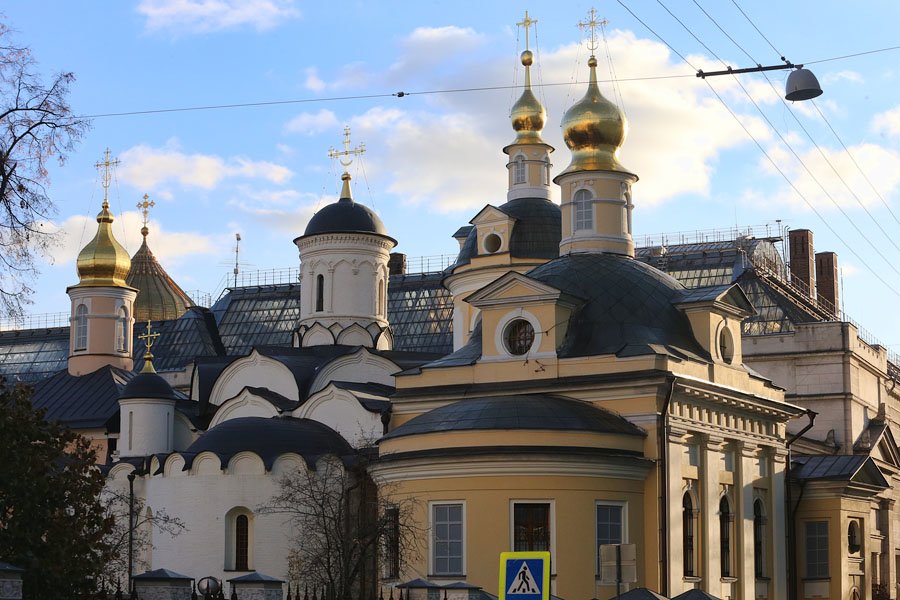История храма священномученика Антипия на Колымажном дворе начинается в XVI в. Каменную церковь в Конюшенной слободе поставили около 1530 г. Храм назывался по своему местоположению: «у больших конюшен», «что в Чертолье», «что у Государевых больших конюшен».
Церковь Антипия интересна тем, что в основе ее два алтаря: во имя свмч. Антипы и малый – во имя св. Григория Декаполита. По легенде, малый алтарь строил Григорий Лукьянович Бельский, более известный как Малюта Скуратов, чей двор находился по соседству.
Святой Антипий – прославленный целитель; по преданию, он помогает избавиться от зубной боли. Это единственный в Москве Антипьевский храм, который привлекал множество страдающих зубной болью москвичей. Сюда шли молиться люди разных сословий из разных частей города. Прихожанами Антипьевского храма были и Лопухины, и Апраксины, и Оболенские; в начале ХХ в. его прихожанином был художник В. Серов, живший неподалеку.
В XVIII в. были пристроены приделы св. Николая Чудотворца (в 1722 г.), великомученицы Екатерины (в 1773 г.) и Рождества Иоанна Предтечи (в 1798 г.).
В 1912 г. напротив церкви открылся Музей изящных искусств императора Александра III. С этих пор судьба музея и храма неразрывно связаны друг с другом.
После революции, в 1929 г., церковь закрыли. Здание было отдано Центральным художественным курсам Ассоциации художников революции. Долгое время оно служило общежитием. Позднее его заняли реставрационные мастерские и отдел хранения ГМИИ им. Пушкина.
В советское время здание не ремонтировалось и было в плачевном состоянии. В 1950-х были сломаны купол и глава южного придела св. Николая.
В 1960-х гг. началась реставрация церкви под руководством архитектора Л.А. Давида. По замыслу реставраторов планировалось снести все части, появившиеся в XVII-XIX вв. Этому помешал Музей им. А.С. Пушкина, являвшийся арендатором.
В 1990-х гг. начата еще одна реставрация. В 1991 г. была образована церковная община, но только в 2005 г. храм удалось передать Русской православной церкви.
According to legend, Gregory Belsky better known as Malyuta Skuratov built a small altar of the church.
The history of the Holy Martyr Antipas temple in Kolymazhny yard begins in the XVI century. Stone church in the Konyushennaya (Stables) Sloboda erected about 1530. The Church called after its location -"by big stables”, “that in Chertolye", "by the Sovereign's large stables."
Church of Antipy is interesting because there are two altars at its heart. Large one is in the name of the Holly Martyr Antipas and a small one in the name of St. Gregory Dekapolit. According to legend, Gregory Belsky better known as Malyuta Skuratov built a small altar of the church. His court was in the neighborhood.
Holy Antipas - renowned healer. According to legend, he helps to get rid of a toothache. This is the only Antipy temple in Moscow and it attracted many Muscovites suffering from toothache. People of different social classes from different parts of the city prayed here. Lopukhins, Apraksins and Obolensky were parishioners of the Church of Antipy. Artist Serov lived nearby and used to pray in the church in the early twentieth century.
In the XVIII century chapels of St. Nicholas (in 1722), Catherine (in 1773) and St. John the Baptist (1798) added to the church.
Museum of Fine Arts of the Emperor Alexander III opened in front of the church in 1912. Since then the fate of the museum and the church are inextricably linked with each other.
The church closed After the revolution in 1929. The building transferred to the Central art courses of the Association of Revolution Artists. It served as a hostel for a long time. Restoration workshops and storage department of the Pushkin Museum of Art took it later.
In Soviet times, the building was not repaired and was in poor condition. Canopy and head of the south aisle of St. Nicholas broken in the 1950s.
The restoration of the church under the supervision of architect LA David began in the 1960s. According to the plan, restorers wanted to demolish all the pieces that appeared in XVII-XIX centuries. Pushkin Museum prevented it as a tenant.
Another restoration launched in the 1990s. The church community founded in 1991, but it became possible to pass the church to the Russian Orthodox Church only in 2005.











%20BEL_0521.jpg&w=1920&q=75)



